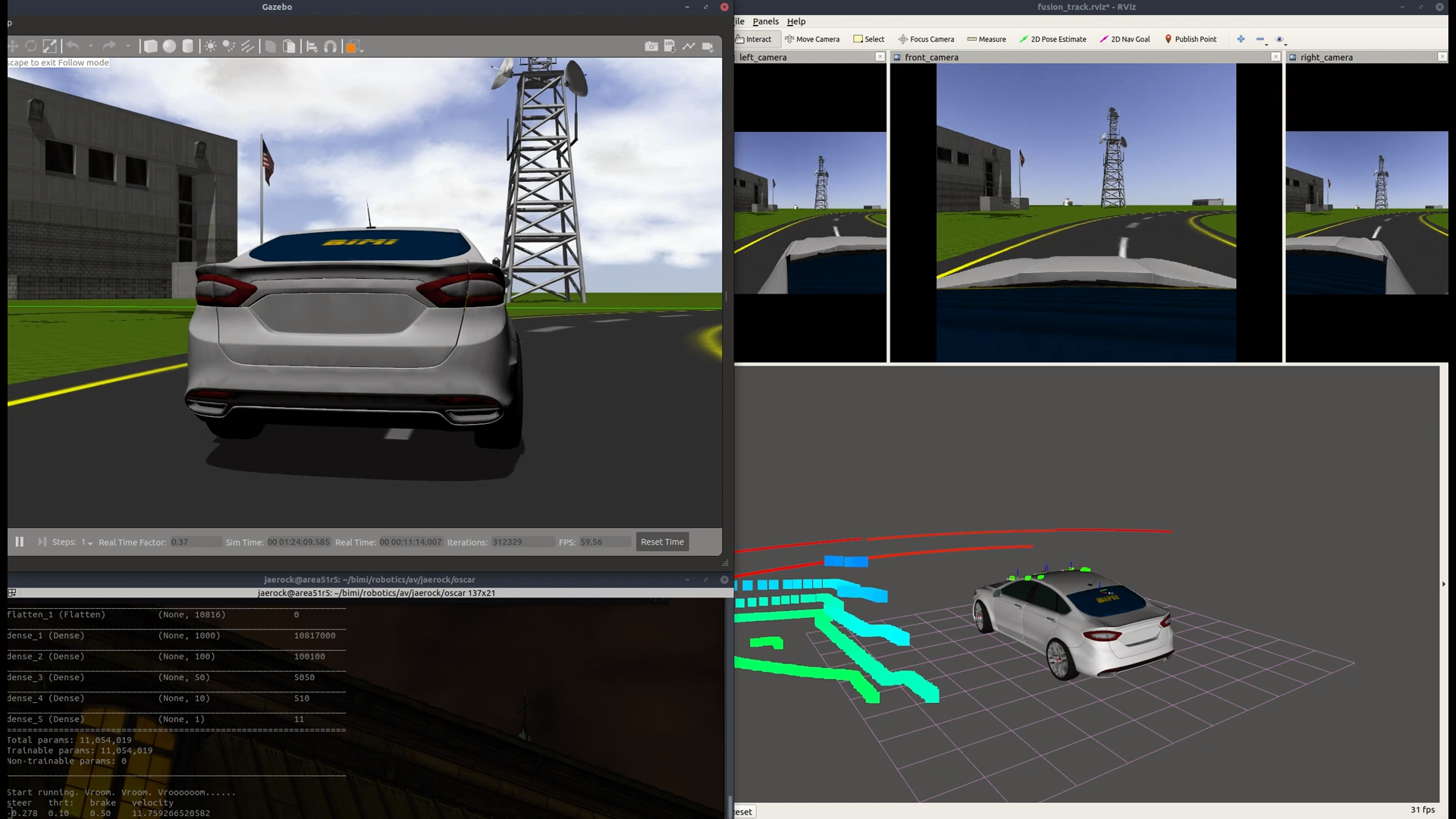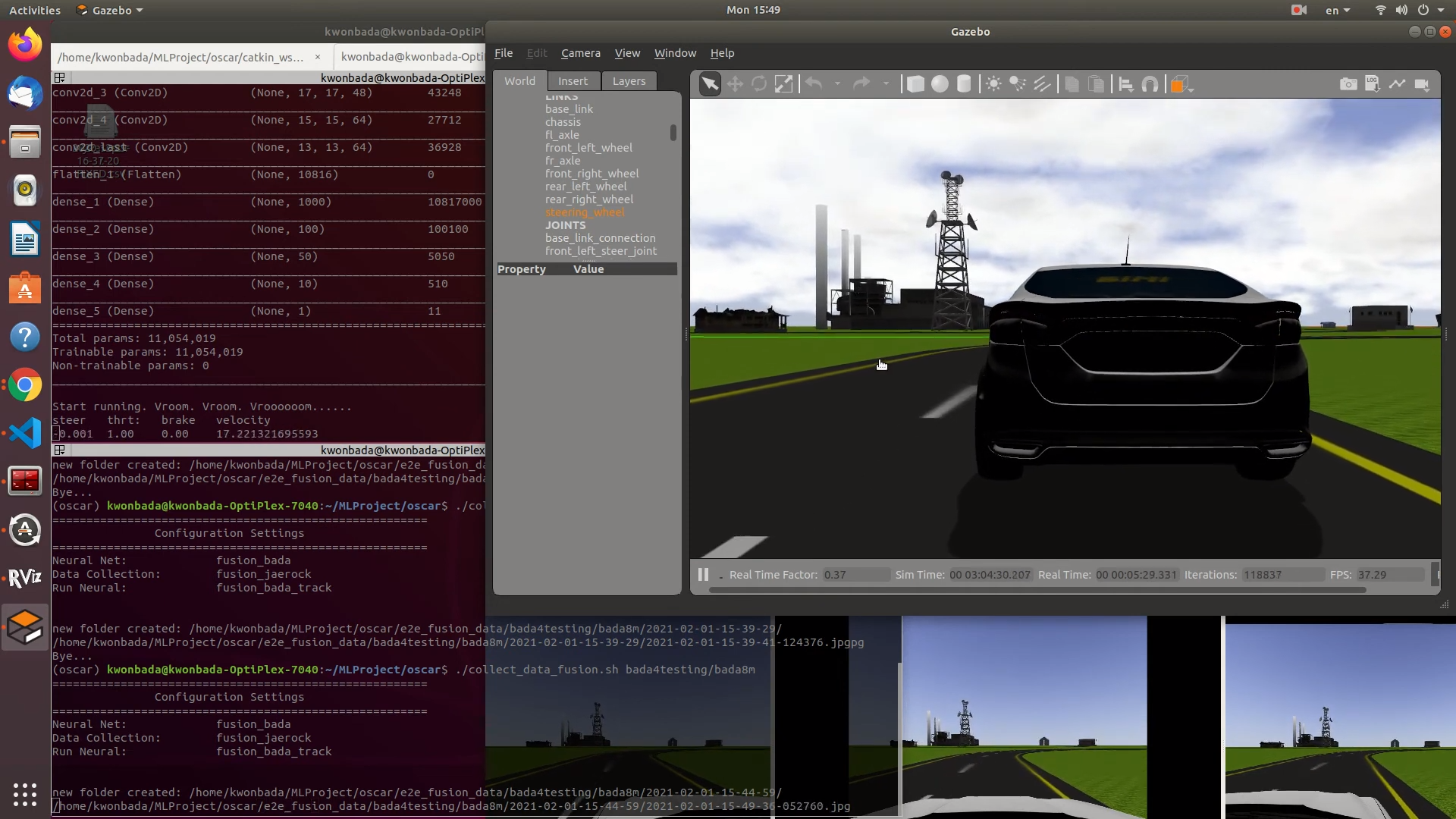 |
 |
 |
 |
 |
 |
- 3/11/2021:
- Removed unused plugins that are not compatible with Gazebo-11.
- Works with Gazebo-11 as well.
- Tested in Ubuntu 20.04 and ROS Noetic. Only checked basic function and not yet fully tested.
- 3/06/2021: Version 1.6 released
- Input can have velocity in addition to image. See
config/neural_net [num_input]. - Output can have throttle in addtion to steering angle.
See config/neural_net [num_output]. - Add
brakeinconfig/data_collection(config version # 0.92 was used previously).
- Input can have velocity in addition to image. See
- 2/18/2021: Version 1.5 released.
- Add 'brake' to the
data_collection. - Update the modules that use data from
data_collection.
- Add 'brake' to the
- 01/15/2021: Version 1.4 released.
- Split one config (neural_net) to three (neural_net, data_collection, run_neural)
- 12/04/2020: Version 1.2 released.
- New data collection policy.
- Data normalization added.
- 11/30/2020: Version 1.0 released.
OSCAR is the Open-Source robotic Car Architecture for Research and education. OSCAR is an open-source and full-stack robotic car architecture to advance robotic research and education in a setting of autonomous vehicles.
The OSCAR platform was designed in the Bio-Inspired Machine Intelligence Lab at the University of Michigan-Dearborn.
The OSCAR supports two vehicles: fusion and rover.
fusion is based on car_demo from OSRF that was originally developed to test simulated Toyota Prius energy efficiency.
The backend system of rover is the PX4 Autopilot with Robotic Operating System (ROS) communicating with PX4 running on hardware or on the Gazebo simulator.
The OSCAR platform can be used by researchers who want to have a full-stack system for a robotic car that can be used in autonomous vehicles and mobile robotics research. OSCAR helps educators who want to teach mobile robotics and/or autonomous vehicles in the classroom. Students also can use the OSCAR platform to learn the principles of robotics programming.
$ git clone https://github.com/jrkwon/oscar.git --recursive
catkin_ws: ros workspacesrcdata_collection: data from front camera and steering/throttlefusion: Ford Fusion Energia modelrover:
config: configurationsconda: conda environment filesconfig.yaml: config file names for neural_net, data_collection, and run_neuralneural_net: system settings for neural_netdata_collection: system settings for data_collectionrun_neural: system settings for run_neural
neural_net: neural network package for end to end learningPX4-Autopilot: The folder for the PX4 Autopilot.
The OSCAR has been tested with ROS Melodic on Ubuntu 18.04.
Install two more packages for this project unless you already have them in your system.
$ sudo apt install ros-$ROS_DISTRO-fake-localization
$ sudo apt install ros-$ROS_DISTRO-joy
Create a conda environment using an environment file that is prepared at config/conda.
$ conda env create --file config/conda/environment.yaml
This section applies to rover which is based on PX4 . When RC signal is lost, the vehicle's default behavior is homing with disarming to protect the vehicle.
We disabled this feature to prevent the vehicle from disarming whenever control signals are not being sent.
Use QGroundControl to disable the feature. Find COM_OBLACT and make it Disable.
Activate the oscar environment.
$ conda activate oscar
This section explains how to use fusion and rover.
fusion is heavily relied on OSRF's car_demo project. Simply use the following script.
(oscar) $ ./start_fusion.sh
A world can be selected through a command line argument. Three worlds are ready to be used.
track_jaerock: This is default. No need to specified.sonoma_raceway: racetrackmcity_jaerock: mcity
(oscar) $ ./start_fusion.sh {sonoma_raceway|mcity_jaerock}
rover is based on the Software-In-The-Loop of PX4.
- Start the rover
(oscar) $ ./start_rover.sh
- Get rover ready to be controlled.
Open a new terminal and run the following shell scripts.
(oscar) $ ./cmd_arming.sh
(oscar) $ ./offboard_mode.sh
Then the rover is ready to be controlled by the topic /mavros/setpoint_velocity/cmd_vel or /mavros/setpoint_velocity/cmd_vel_unstamped. The OSCAR uses the unstamped version.
Run the script with a data ID as an argument.
(oscar) $ ./collect_data_fusion jaerock
The default data folder location is $(pwd)e2e_{fusion/rover}_data.
From data_collection config version 0.92, the CSV file has one more column for brake. Use convert_csv.py to convert a data CSV file collected before 0.92 to a new CSV file.
Data Collection will save a csv file with images. The CSV file has following columns
image_file_name / steering_angle / throttle / brake / linux_time / velocity / velocity_x / velocity_y / velocity_z / position_x / position_y / position_z
2020-12-08-23-55-31-150079.jpg -0.0149267930537 0.15 0.7 1607489731.15 0.846993743317 0.846750728334 -0.00903874268025 -0.0181633261171 8.25840907119 -102.836707258 0.0248406100056
Data Collection will save a csv file with images. The CSV file has following columns
image_file_name / steering_angle / throttle / linux_time / velocity / velocity_x / velocity_y / velocity_z / position_x / position_y / position_z
2020-12-08-23-55-31-150079.jpg -0.0149267930537 0.15 1607489731.15 0.846993743317 0.846750728334 -0.00903874268025 -0.0181633261171 8.25840907119 -102.836707258 0.0248406100056
When some of test images must be deleted, just delete them and rebuild the csv using rebuild_csv.py.
(oscar) $ python rebuild_csv.py path/to/data/folder
steering_angle_scale in neural_net config is for making the neural network have higher precision in prediction. The range of steering angle is -1 to 1. But in most cases, there will not be values between -1 and -0.5 as well as between 0.5 to 1 which means very sharp steering angles. These sharp steering angles will not be collected from driving a track in practice.
To find a proper scale value, you may use test_data.py by which you can see data statistics. The following is an example.
The choice of steering_angle_scale is especially important when activation functions are sigmoid or tanh in which you may lose data samples of sharp turns.
####### data statistics #########
Steering Command Statistics:
count 6261.000000
mean 0.002407
std 0.134601
min -0.421035
25% -0.016988
50% 0.009774
75% 0.085238
max 0.310105
Name: steering_angle, dtype: float64
Start a training
(oscar) $ . setup.bash
(oscar) $ python neural_net/train.py path/to/data/folder
After starting a training session, start tensorboard.
(oscar) $ tensorboard --logdir ./logs/scalars/
TBA
(oscar) $ . setup.bash
(oscar) $ python neural_net/test.py path/to/data/model path/to/data/folder
To compare labeled steering angles and their corresponding ones.
(oscar) $ . setup.bash
(oscar) $ python neural_net/drive_log.py path/to/data/model path/to/data/folder
TBA
(oscar) $ . setup.bash
(oscar) $ python neural_net/test_saliency.py path/to/data/model path/to/image/to/test
TBA
(oscar) $ . setup.bash
(oscar) $ rosrun run_neural run_nerual.py path/to/data/model
You can specify a trained neural network model to see how the inference engine is actually working.
(oscar) $ python neural_net/drive_view.py path/to/data/model path/to/data/folder path/to/folder/to/save
It is also possible to visualize collected data with other information without steering angle predictions.
(oscar) $ python neural_net/drive_view.py path/to/data/folder path/to/folder/to/save
The datasets below were collected before we added brake. The CSV files must be converted by convert_csv.py before being used.
$ sudo apt install ros-$ROS_DISTRO-hector-gazebo-plugins
- Jaerock Kwon, Aws Khalil, Donghyun Kim, Haewoon Nam, “Incremental End-to-End Learning for Lateral Control in Autonomous Driving,” IEEE Access, 2022.
- Aws Khalil, Ahmed Abdelhamed, Girma Tewolde, Jaerock Kwon, “Ridon Vehicle: Drive-by-Wire System for Scaled Vehicle Platform and Its Application on Behavior Cloning,” MDPI Energies, Special Issue “Autonomous Vehicles Perception and Control,” 2021.
- Byung Chan Choi, Jaerock Kwon, Haewoon Nam, “Image Prediction for Lane Following Assist using Convolutional Neural Network-based U-Net,” The 4th International Conference on Artificial Intelligence in Information and Communication (ICAIIC 2022), Feb 21-24, 2022
- Donghyun Kim, Jaerock Kwon, Haewoon Nam, “End-to-End Learning-based Self-Driving Control Imitating Human Driving”, The 12th International Conference on ICT Convergence (ICTC 2021), Jeju Island, Korea, October 20-22, 2021
- Ahmed Abdelhamed, Girma Tewolde, and Jaerock Kwon, Simulation Framework for Development and Testing of Autonomous Vehicles, International IOT, Electronics and Mechatronics Conference, Vancouver, Canada, Sep 2020
- Nikhil Prabhu, Sewoong Min, Haewoon Nam, Girma Tewolde, and Jaerock Kwon, Integrated Framework of Autonomous Vehicle with Traffic Sign Recognition in Simulation Environment, IEEE International Conference on Electro/Information Technology, Naperville, IL, USA, July 2020
- Shobit Sharma, Girma Tewolde, and Jaerock Kwon, Lateral and Longitudinal Motion Control of Autonomous Vehicles using Deep Learning, IEEE International Conference on Electro/Information Technology, Brookings, South Dakota, USA, May 2019
- Jaerock Kwon, Ph.D.: Assistant Professor of Electrical and Computer Engineering at the University of Michigan-Dearborn
- Donghyun Kim: Ph.D. student at Hanyang University-ERICA, Korea
- Aws Khalil: Ph.D. student at the University of Michigan-Dearborn
- Jesudara Omidokun: M.S. student at the University of Michigan-Dearborn